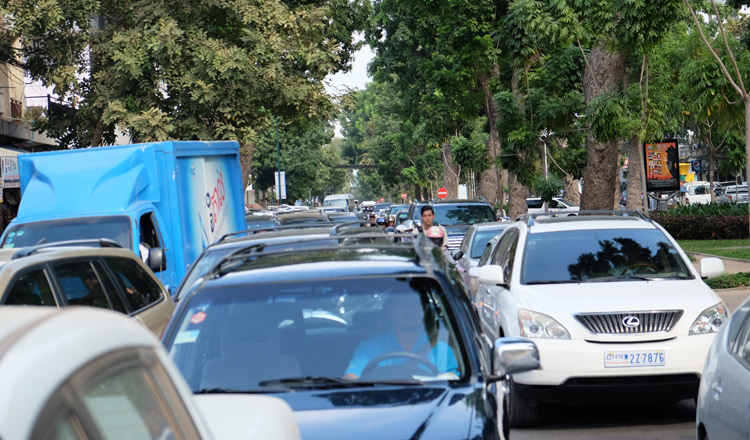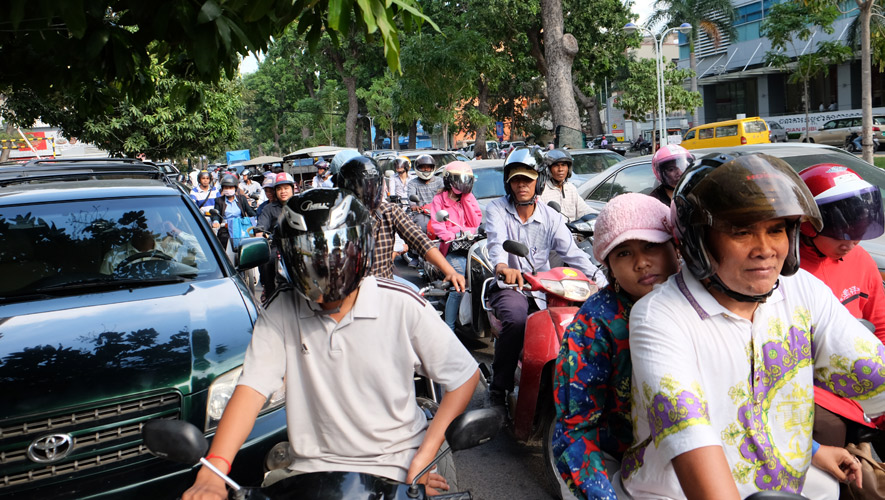In a city of two million, Cambodian capital Phnom Penh, with an annual average population growth rate of 3.33 percent, is no stranger to daily traffic congestions that choke its main thoroughfares.
For the latest Cambodian Business news, visit Khmer Times Business
Traffic has increased yearon- year as city dwellers with higher disposable income invest in private ownership of vehicles, as evidenced in the 37 percent rise in vehicle registration to 241,671 in 2018 from 176,389 a year ago.
Data from Public Works and Transport Ministry shows that Phnom Penh made up 41 percent of the overall Cambodian vehicle registration of 579,896 in 2018. Motorcycle registrations represented 68 percent of the 2018 figure while 73,509 cars were recorded in the same period. For 2019, the authorities have already recorded 36,804 vehicle registrations up to Feb 11.
Notably, traffic congestion is also a result of increased usage of ride-hailing app services, and most importantly the failure of motorists in observing road rules, and lax law enforcement. Rubbing salt into wound, the current infrastructure also does not support the significant traffic growth, a French colonial inheritance from nearly a century ago when the population was small.
To reduce congestion, efforts are being made by the government to build more roads, Va Sim Sorya, spokesman for Public Works and Transport Ministry tells Capital Cambodia. “A big city like Phnom Penh needs a ring road. We need more roads. We have referred this to the City Hall as they are in charge of road upgrades,” he says. Having said that, the trend of using public transportation is on the rise as people look at saving cost.
According to Phnom Penh City Bus Authority, the number of commuters grew to 26,000 in 2018 from 6,000 some years ago, slightly easing the congestion in some parts. “But can you imagine if these 26,000 people used their own vehicles? The roads will be choc-a-bloc with cars and motorcycles daily, and they would collectively spend $26,000 daily or $9.5 million a year for gasoline,” its governor Ean Sokhim says.

The capital has a total of 235 buses and 13 routes catering to urban dwellers daily such as elderly people, garment workers and students. “Of the 13 bus lines, only Line No 3 and 4 are most popular. We have 5,500 to 6,000 passengers per day riding these routes because it passes through i n d u s t r i a l , commercial, residential and school areas,” he says.
Though public transportation is a non-profit service, Sokhim says the government can consider subsidising the expense that currently costs the City Hall $100,000 per month.
“Although loss-making, the service would reduce congestion and accidents. The people can also enjoy the free ride,” he adds. Acting country head Sotheavy Heng of ride-hailing service Grab finds its arrival in the city a year ago as coinciding with Phnom Penh’s congestion, which she views as part of Cambodia’s population and economic growth.
“Transport options in Cambodia continue to develop to meet the needs of citizens and industry as the population, and financial security of Cambodians grow,” she says. She, however, agrees that the existing transport infrastructure has struggled to keep up with the change of pace. “With the growth in population and vehicle ownership, urban roads have come under strain.
We are working to find ways to alleviate congestion with relevant parties and ensure that everyone has access to safe, secure and convenient transport options,” she says. Grab is cooperating with the Public Works and Transport Ministry, and United Nations Development Programme on the Sustainable Urban Mobility for All Initiative project to utilise road usage data collected by its driver-partners daily.
“The data allows the authorities to find ways to improve the provision for public transport and plan road infrastructure to prepare Phnom Penh to cope with the future needs of its residents,” says Heng. CapCam
Sok Chan
Business Writer, Capital Cambodia




